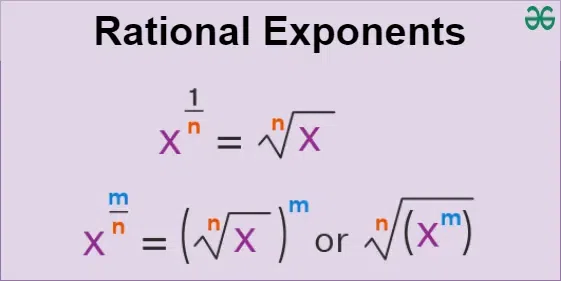
|
|
Rational exponents (also called fractional exponents) are expressions with exponents that are rational numbers. Rational exponents follow similar properties as integer exponents, including the product, quotient, and power rules. Rational exponents are used across various fields like physics, engineering and finance. In this article, we will discuss the rational exponent’s definition, their formula, solved examples and others in detail. Table of Content What are Rational Exponents?Rational exponents are exponents that are expressed as fractions. They are a way of representing roots and powers simultaneously. We know that exponents are the way of representing numbers with powers, i..e. of the form am and rational exponents are the exponents where the exponent part(m) is a rational number, i.e. m is of the form p/q; (m = p/q).  Rational Exponents Examples of rational exponents are: 34/5, (11)-2/3, (-7/9)1/3, etc. Rational Exponents DefinitionRational exponents involve raising a number to a fractional power where the numerator of the fraction represents the power to which the base is raised and the denominator represents the root to be taken. Rational Exponents Notation General notation of rational exponents is ap/q, where a is the base and p/q is a rational exponent. Rational exponents can also be written as
Properties of normal exponents holds true for rational exponents also. Rational Exponents FormulasGeneral formula for rational exponents is:
where
The rational exponent formula relates a rational exponent a{m/n} to its equivalent radical expression, allowing for easy conversion between the two notations. a{m/n} = n√{am} This formula explains that raising a number a to the power of m/n is equivalent to taking the n-th root of am. It serves as the basis for understanding and solving expressions involving rational exponents. Various formulas used in exponets also hold true for rational exponents that includes:
where,
Properties of Rational ExponentsProperties such as the power of a quotient, power of a product and power of a power apply to rational exponents, compared to integer exponents. Rational exponents possess several properties that extend the laws of integer exponents to fractional exponents, enabling efficient manipulation of expressions involving powers and roots.
Rational Exponents and RadicalsRational exponets can easily be written as radicals. This is explained using the steps added below: Take the rational exponent ap/q this can be changed to radical form as: Step 1: Observe the given rational exponent, ap/q and now the numerator of the rational exponent is the power. In ap/q, p is the power. Step 2: Again observe the given rational exponent, ap/q and now the denominator of the rational exponent is the root. In ap/q, q is the root. Step 3: Write, base as the radicand, power raising to the radicand, and the root as the index. i.e.
This is explained by the example: (3)2/3 = 3√(3)2 Rational Exponents and RadicalsConverting between rational exponents and radical notation involves understanding that the exponent represents both the power and the root of a number. To convert between rational exponents and radical notation, express the exponent as a fraction and identify the power and root accordingly. Difference Between Rational Exponents and Radical NotationRational exponents and radical notation are interchangeable forms of expressing the same mathematical concept, where a rational exponent is equivalent to a radical expression.
Simplifying Rational ExponentsWe can easily simplify rational exponents by simplifying them into their simplest form using radicals. This is explained by the example added below: Example: Simplify (27)4/3 Solution:
Rational Exponents with Negative BasesRational exponents with negative bases follow the same rules as those with positive bases, with considerations for even roots resulting in complex solutions. Examples of rational exponent with negative base are:
Non-Integer Rational ExponentsNon-integer rational exponents represent fractional powers or roots of numbers extending beyond whole numbers and integers. General format of a rational exponent is:
where
Various examples of non integer rational exponents are: (15)0.3, (6)2.5, (5)2/3, (11)1/2, (5/6)3/4, etc. Simplifying Non-Integer Rational ExponentsNon-integer rational exponents are solved in the same way as exponents with integers are solved. Following exponent rules are used to solve the exponents.
Applications of Rational ExponentsRational exponents find applications in various fields such as engineering, physics and finance in calculations involving fractional powers and roots. They are used in:
Examples on Rational ExponentsExample 1: Simplify 8{2/3} Solution:
Example 2: Evaluate 27{-2/3} Solution:
Example 3: Simplify 163/2 Solution:
Example 4: Calculate the values of 251/2 Solution:
Example 5: Simplify the expression: 813/4 Solution:
Practice Questions on Rational ExponentsQ1. Simplify the expression: 275/3 Q2. Calculate the value of expression: 81/3 Q3. Evaluate the expression: 163/4 Q4. Simplify the expression: 43/2 Q5. Find the value of the expression: 815/4 FAQS on Rational ExponentWhat is the General Form of Expressing a Number with a Rational Exponent?
Can Rational Exponents be Negative?
How are Rational Exponents used in Simplifying Expressions?
What are Some Properties of Rational Exponents?
Can Rational Exponents be used with Variables?
How are Rational Exponents Applied in Real-life Situations?
What is the Difference Between Rational and Irrational Exponents?
|
||||||||||||||||||||||
Reffered: https://www.geeksforgeeks.org
| Mathematics |
Type: | Geek |
Category: | Coding |
Sub Category: | Tutorial |
Uploaded by: | Admin |
Views: | 7 |